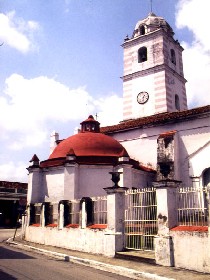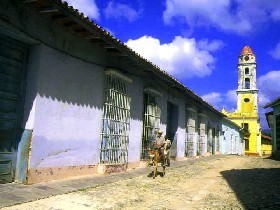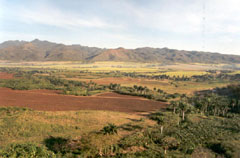|
BRIDGE OVER THE YAYABO RIVER
The Yayabo Bridge (Puente Yayabo), which rises up over the city of Sancti Spíritus, is the only one of its type in Cuba and one of the most ancient in the country. It was built from bricks, lime and sand from the surrounding area, without using cement, according to one technical report from the laboratory of the National Centre of Conservation, Restoration and Museums.
Maribí Cabrera, an engineer from the Centre of Patrimony in this Cuban province, in declarations to Prensa Latina commented that the study, carried out with different samples, contradicted the theory of the use of cement brought all the way from Italy, which supposedly influenced the strength of the building, now a National Monument, that is still standing today.
Cabrera and Anai Gómez, two specialists that requested the investigation, said that the confusion came from the use of the term “roman cement", which was used during this period to refer to a mixture of lime, sand and puzzolana (volcanic rocks, bricks, tiles or other ceramic materials) which were pulverised by mechanical means, for use as a construction material.
Another fact which confirms this theory is that cement was patented in 1844, much later than the final construction of the bridge between the two shores. The specialists have explained that its resistance is due to the use of local materials and not imported ones from Europe.
The Capitulary Acts (Actas Capitulares) and other documents of the colonial period which were examined, contain even yet another surprise, the construction of the Yayabo bridge was carried out by prisoners of the area and not by slaves, as had originally been thought.
Pour davantage d'information:
www.cuba-architecture.com
,
www.cuba-history.com
,
www.cuba-sanctispiritus.com
|
|
|
CABALLETE DE CASA
Caballete de Casa, among the Escambray mountains, in the centre of the island, was the site chosen by the Comandante Guerrillero (Ernesto Che Guevara) for establishing his headquarters.
Ernesto Che Guevara’s Headquarters (Comandancia de Ernesto Che Guevara) during the struggle before 1959, located in Caballete de Casa, in the mountain massif of the Escambray, in the centre of the country, is currently being restored.
According to the National Agency of Information (Agencia de Información Nacional), the work being carried out reproduces exactly the legendary facilities used by the heroic warrior of Argentine-Cuban descent, as a training school for the Number Eight Column of the Rebel Army (Ejercito Rebelde), before 1959.
The ensemble, declared a National Monument 20 years ago, has a structure of rustic wooden props, covered by palm leaves.
Caballete de Casa, some 440 kilometres southeast of Havana, is the highest elevation of Fomento’s geography, in the province of Sancti Spíritus, 764 metres above sea level.
Pour davantage d'information:
www.cuba-che.com
,
www.cuba-escambray.com
,
www.cuba-heroes.com
,
www.cuba-history.com
,
www.cuba-sanctispiritus.com
|
|
|
MANACAS IZNAGA TOWER
Today one can still admire as a vestige of the ancient grandeur of the surrounding area of Trinidad, the elegant bell tower of the Manacas-Iznaga sugar mill, declared together with the city of Trinidad, a National Monument.
One can also see the house of the ancient Bella Vista sugar mill, built in the fourth decade of the nineteenth century by the wealthy Don Pedro Malibrán, in the most severe roman style.
Also outstanding due to its authentic native style, is the house of the Guáimaro sugar mill, one of the most productive of that period. Among the remains of the Manacas-Iznaga “batey”, there are some “bohíos” from a settlement of slaves, considered among the largest in 1857.
The colourful vegetation of the Valley of the Sugar Mills (Valle de los Ingenios) surrounds these remains of Cuban past with their own magic. The tableau is completed with the Manacas-Iznaga tower, built in 1816.
Pour davantage d'information:
www.cuba-history.com
,
www.cuba-sugar.com
,
www.cuba-sanctispiritus.com
|
|
|
REMAINS OF THE TRAIL (TROCHA) FROM JÚCARO TO MORÓN
A brief history of the Trail (Trocha) from Júcaro to Morón.
In the wars of 1868 and 1895, the Trocha was an insurmountable barrier, as the Spanish thought, and after it was finished, it became the most perfect and sophisticated military construction that the Spanish Colonialism had in America. Of course it was never a deterrent for the glorious Mambi Army (Ejército Mambí), who in both wars kept crossing it ,showing the ingenious strategies deployed by their military chiefs, among them Máximo Gómez and Antonio Maceo, with the help of other insurrectional chiefs of the area, such as Brigadier José Gómez Cardoso and Colonel Simón Reyes Hernández, known as the Eagle of the Trocha (El Águila de la Trocha).
The aim of this military line was to isolate the mambi forces in the eastern area, in order to deter help and break contact between the insurrectional forces in the central and eastern regions, and to stop the invaders, led by Máximo Gómez and Antonio Maceo from extending the war to the western region of the country, an event that would wear down the strength of Spanish colonialism, leading up to its final fall.
By the end of March of 1871, three years from the Cry of Yara (Grito de Yara), General Blas Villate de la Hera, Count of Valmaseda, proposed to the Overseas Minister of the Spanish Crown; the construction of a trocha or fortified line, from the port of Júcaro, on the southern coast; running across the island, to the settlement of Morón, on the northern coast.
Valmaseda’s proposal was approved, and construction on the trocha was started. It started out with 17 fortresses and in 1874, 16 bunkers had been added on, more than five thousand men were employed to guard it, these soldiers had modern infantry weapons as well as ten pieces of artillery, which were moved along the Trocha by a narrow railway, which also allowed them to quickly move the troops from one end to the other.
Pour davantage d'information:
www.cuba-heroes.com
,
www.cuba-history.com
,
www.cuba-matanzas.com
,
www.cuba-cienfuegos.com
,
www.cuba-villaclara.com
,
www.cuba-sanctispiritus.com
|
|
|
SANCTI SPÍRITUS
 C’est une province où existent d’excellents attraits touristiques, parmi lesquels la Villa de la Santisima Trinidad, distante de 67 kilomètres de la Villa del Espiritu Santo capitale de la province de Sancti Spiritus.
Elle est fondée en 1514 et est parmi les sept premières villes établies par les espagnoles dans l’île.
Parmi les lieux à visiter se trouvent l’église Mayor, le Théâtre Principal et le Pont sur le fleuve Yayabo.
Ce dernier fut conçut pour le passage des charrettes et des roulottes, il conserve aujourd’hui sa sveltesse des anciens temps et il est considéré par beaucoup de gens comme un musée à ciel ouvert.
Le style baroque est visible dans une bonne partie de ses demeures et le style classique de l’église Iglesia Mayor, avec sa petite place, évolua jusqu’à des constructions plus adaptées au climat du pays.
Près de la vieille ville, dans la partie de la Route Centrale qui conduit à Jatibonico, se trouve le lac artificiel de Zaza, avec une capacité de 1 200 millions de mètres cube d’eau, c’est un endroit où l’on pratique la pêche à la truite avec comme antécédents de notables exemplaires pêchés.
C’est une province où existent d’excellents attraits touristiques, parmi lesquels la Villa de la Santisima Trinidad, distante de 67 kilomètres de la Villa del Espiritu Santo capitale de la province de Sancti Spiritus.
Elle est fondée en 1514 et est parmi les sept premières villes établies par les espagnoles dans l’île.
Parmi les lieux à visiter se trouvent l’église Mayor, le Théâtre Principal et le Pont sur le fleuve Yayabo.
Ce dernier fut conçut pour le passage des charrettes et des roulottes, il conserve aujourd’hui sa sveltesse des anciens temps et il est considéré par beaucoup de gens comme un musée à ciel ouvert.
Le style baroque est visible dans une bonne partie de ses demeures et le style classique de l’église Iglesia Mayor, avec sa petite place, évolua jusqu’à des constructions plus adaptées au climat du pays.
Près de la vieille ville, dans la partie de la Route Centrale qui conduit à Jatibonico, se trouve le lac artificiel de Zaza, avec une capacité de 1 200 millions de mètres cube d’eau, c’est un endroit où l’on pratique la pêche à la truite avec comme antécédents de notables exemplaires pêchés.
Pour davantage d'information:
www.cuba-escambray.com
,
www.cuba-trinidad.com
,
www.cuba-sanctispiritus.com
|
|
|
TRINIDAD
 La Ville de Trinidad, troisième fondée dans le pays, se trouvait à l’origine sur les bords du fleuve Tuinucú, et fut postérieurement déplacée sur les rives du fleuve Yayabo en 1552. Elle contient des valeurs architecturales ainsi que culturelles et de beaux paysages qui forment un tout harmonieux pour celui qui la visite.
Déclarée Patrimoine de l’Humanité par l’UNESCO en décembre 1998, elle invite à parcourir ses rues pavées et à découvrir chaque événement historique de la ville conservée par ses habitants avec une attention extrême.
L’industrie sucrière et ses splendeurs racontent aussi l’histoire de la ville, avec la vallée de San Luis aussi appelée vallée de Los Ingenios, qui constitue une importante réserve archéologique.
Mais la tour Iznaga est la plus visitée de tous, solitaire hauteur élevée pendant le première moitié du 19ème siècle, comme une tour de guet avec comme objectif la surveillance et l’organisation du travail des esclaves. La tour, de sept étages et quarante cinq mètres de haut, rythmait les activités quotidiennes et les prières.
Elle fut aussi déclarée Patrimoine de l’Humanité par l’UNESCO.
La Ville de Trinidad, troisième fondée dans le pays, se trouvait à l’origine sur les bords du fleuve Tuinucú, et fut postérieurement déplacée sur les rives du fleuve Yayabo en 1552. Elle contient des valeurs architecturales ainsi que culturelles et de beaux paysages qui forment un tout harmonieux pour celui qui la visite.
Déclarée Patrimoine de l’Humanité par l’UNESCO en décembre 1998, elle invite à parcourir ses rues pavées et à découvrir chaque événement historique de la ville conservée par ses habitants avec une attention extrême.
L’industrie sucrière et ses splendeurs racontent aussi l’histoire de la ville, avec la vallée de San Luis aussi appelée vallée de Los Ingenios, qui constitue une importante réserve archéologique.
Mais la tour Iznaga est la plus visitée de tous, solitaire hauteur élevée pendant le première moitié du 19ème siècle, comme une tour de guet avec comme objectif la surveillance et l’organisation du travail des esclaves. La tour, de sept étages et quarante cinq mètres de haut, rythmait les activités quotidiennes et les prières.
Elle fut aussi déclarée Patrimoine de l’Humanité par l’UNESCO.
Pour davantage d'information:
www.cuba-escambray.com
,
www.cuba-trinidad.com
,
www.cuba-sanctispiritus.com
|
|
|
VALLÉE DE “LOS INGENIOS”
 Près de la légendaire ville de Trinidad, avec ses 277 kilomètres carrés de superficie, cette merveilleuse œuvre de la nature se trouve dans le massif montagneux de l’Escambray, dans la province de Santi Spiritu. Depuis décembre 1988 la Vallée fut nommée Patrimoine de l’Humanité par l’UNESCO. Dans son vaste territoire se trouve un total de 77 sites archéologiques de ci qui fut, à partir de la colonisation espagnole, l’industrie sucrière cubaine naissante et parmi ces lieux se trouvent onze haciendas, certaines totalement reconstruites, d’autres considérées comme ruines, les restent constructifs de trois usines de sucre, des machines et des objets de la vie productive, ainsi que des baraques où vivaient des esclaves, des entrepôts, deux tours clochers et d’autres empreintes d’architecture locale dans trois villages ruraux.
Près de la légendaire ville de Trinidad, avec ses 277 kilomètres carrés de superficie, cette merveilleuse œuvre de la nature se trouve dans le massif montagneux de l’Escambray, dans la province de Santi Spiritu. Depuis décembre 1988 la Vallée fut nommée Patrimoine de l’Humanité par l’UNESCO. Dans son vaste territoire se trouve un total de 77 sites archéologiques de ci qui fut, à partir de la colonisation espagnole, l’industrie sucrière cubaine naissante et parmi ces lieux se trouvent onze haciendas, certaines totalement reconstruites, d’autres considérées comme ruines, les restent constructifs de trois usines de sucre, des machines et des objets de la vie productive, ainsi que des baraques où vivaient des esclaves, des entrepôts, deux tours clochers et d’autres empreintes d’architecture locale dans trois villages ruraux.
Pour davantage d'information:
www.cuba-history.com
,
www.cuba-sanctispiritus.com
|
|
 C’est une province où existent d’excellents attraits touristiques, parmi lesquels la Villa de la Santisima Trinidad, distante de 67 kilomètres de la Villa del Espiritu Santo capitale de la province de Sancti Spiritus.
Elle est fondée en 1514 et est parmi les sept premières villes établies par les espagnoles dans l’île.
Parmi les lieux à visiter se trouvent l’église Mayor, le Théâtre Principal et le Pont sur le fleuve Yayabo.
Ce dernier fut conçut pour le passage des charrettes et des roulottes, il conserve aujourd’hui sa sveltesse des anciens temps et il est considéré par beaucoup de gens comme un musée à ciel ouvert.
Le style baroque est visible dans une bonne partie de ses demeures et le style classique de l’église Iglesia Mayor, avec sa petite place, évolua jusqu’à des constructions plus adaptées au climat du pays.
Près de la vieille ville, dans la partie de la Route Centrale qui conduit à Jatibonico, se trouve le lac artificiel de Zaza, avec une capacité de 1 200 millions de mètres cube d’eau, c’est un endroit où l’on pratique la pêche à la truite avec comme antécédents de notables exemplaires pêchés.
C’est une province où existent d’excellents attraits touristiques, parmi lesquels la Villa de la Santisima Trinidad, distante de 67 kilomètres de la Villa del Espiritu Santo capitale de la province de Sancti Spiritus.
Elle est fondée en 1514 et est parmi les sept premières villes établies par les espagnoles dans l’île.
Parmi les lieux à visiter se trouvent l’église Mayor, le Théâtre Principal et le Pont sur le fleuve Yayabo.
Ce dernier fut conçut pour le passage des charrettes et des roulottes, il conserve aujourd’hui sa sveltesse des anciens temps et il est considéré par beaucoup de gens comme un musée à ciel ouvert.
Le style baroque est visible dans une bonne partie de ses demeures et le style classique de l’église Iglesia Mayor, avec sa petite place, évolua jusqu’à des constructions plus adaptées au climat du pays.
Près de la vieille ville, dans la partie de la Route Centrale qui conduit à Jatibonico, se trouve le lac artificiel de Zaza, avec une capacité de 1 200 millions de mètres cube d’eau, c’est un endroit où l’on pratique la pêche à la truite avec comme antécédents de notables exemplaires pêchés. La Ville de Trinidad, troisième fondée dans le pays, se trouvait à l’origine sur les bords du fleuve Tuinucú, et fut postérieurement déplacée sur les rives du fleuve Yayabo en 1552. Elle contient des valeurs architecturales ainsi que culturelles et de beaux paysages qui forment un tout harmonieux pour celui qui la visite.
Déclarée Patrimoine de l’Humanité par l’UNESCO en décembre 1998, elle invite à parcourir ses rues pavées et à découvrir chaque événement historique de la ville conservée par ses habitants avec une attention extrême.
L’industrie sucrière et ses splendeurs racontent aussi l’histoire de la ville, avec la vallée de San Luis aussi appelée vallée de Los Ingenios, qui constitue une importante réserve archéologique.
Mais la tour Iznaga est la plus visitée de tous, solitaire hauteur élevée pendant le première moitié du 19ème siècle, comme une tour de guet avec comme objectif la surveillance et l’organisation du travail des esclaves. La tour, de sept étages et quarante cinq mètres de haut, rythmait les activités quotidiennes et les prières.
Elle fut aussi déclarée Patrimoine de l’Humanité par l’UNESCO.
La Ville de Trinidad, troisième fondée dans le pays, se trouvait à l’origine sur les bords du fleuve Tuinucú, et fut postérieurement déplacée sur les rives du fleuve Yayabo en 1552. Elle contient des valeurs architecturales ainsi que culturelles et de beaux paysages qui forment un tout harmonieux pour celui qui la visite.
Déclarée Patrimoine de l’Humanité par l’UNESCO en décembre 1998, elle invite à parcourir ses rues pavées et à découvrir chaque événement historique de la ville conservée par ses habitants avec une attention extrême.
L’industrie sucrière et ses splendeurs racontent aussi l’histoire de la ville, avec la vallée de San Luis aussi appelée vallée de Los Ingenios, qui constitue une importante réserve archéologique.
Mais la tour Iznaga est la plus visitée de tous, solitaire hauteur élevée pendant le première moitié du 19ème siècle, comme une tour de guet avec comme objectif la surveillance et l’organisation du travail des esclaves. La tour, de sept étages et quarante cinq mètres de haut, rythmait les activités quotidiennes et les prières.
Elle fut aussi déclarée Patrimoine de l’Humanité par l’UNESCO. Près de la légendaire ville de Trinidad, avec ses 277 kilomètres carrés de superficie, cette merveilleuse œuvre de la nature se trouve dans le massif montagneux de l’Escambray, dans la province de Santi Spiritu. Depuis décembre 1988 la Vallée fut nommée Patrimoine de l’Humanité par l’UNESCO. Dans son vaste territoire se trouve un total de 77 sites archéologiques de ci qui fut, à partir de la colonisation espagnole, l’industrie sucrière cubaine naissante et parmi ces lieux se trouvent onze haciendas, certaines totalement reconstruites, d’autres considérées comme ruines, les restent constructifs de trois usines de sucre, des machines et des objets de la vie productive, ainsi que des baraques où vivaient des esclaves, des entrepôts, deux tours clochers et d’autres empreintes d’architecture locale dans trois villages ruraux.
Près de la légendaire ville de Trinidad, avec ses 277 kilomètres carrés de superficie, cette merveilleuse œuvre de la nature se trouve dans le massif montagneux de l’Escambray, dans la province de Santi Spiritu. Depuis décembre 1988 la Vallée fut nommée Patrimoine de l’Humanité par l’UNESCO. Dans son vaste territoire se trouve un total de 77 sites archéologiques de ci qui fut, à partir de la colonisation espagnole, l’industrie sucrière cubaine naissante et parmi ces lieux se trouvent onze haciendas, certaines totalement reconstruites, d’autres considérées comme ruines, les restent constructifs de trois usines de sucre, des machines et des objets de la vie productive, ainsi que des baraques où vivaient des esclaves, des entrepôts, deux tours clochers et d’autres empreintes d’architecture locale dans trois villages ruraux.